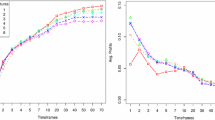Abstract
A new approach to algorithmic trading system development is presented. This approach, Kernel Price Pattern Trading (KPPT P ), allows the practitioner to link the performance of a learned classifier (that predicts the occurrence of the price pattern P) to the profitability of the system. A positive definite kernel based distance that tries to capture the drivers of the process of price patterns formation and some results about the profitability of the system are also presented.
Similar content being viewed by others
Explore related subjects
Discover the latest articles, news and stories from top researchers in related subjects.References
Deboeck G (ed) (1994) Trading on the edge: neural, genetic, and fuzzy systems for chaotic financial markets. Wiley, New York
Trippi R, Turban E (eds) (1996) Neural networks in finance and investing. Irwin, New Brunswick
Shadbolt J, Taylor J (eds) (2002) Neural networks and the financial markets. Springer, Berlin
Chen S, Wang P (eds) (1998) Computational intelligence in economics and finance. Springer, Berlin
Yang H, Chan L, King I (2002) Support vector machine regression for volatile stock market prediction, IDEAL 2002. Lecture notes in computer science, vol 2412, pp 391–396
Cao L, Tay F (2001) Financial forecasting using support vector machines. Neural Comput Appl 10(2):184–192
Moody J, Saffel M (2001) Learning to trade via direct reinforcement. IEEE Trans Neural Netw 12(4):875–889
Harland Z, Using support vector machines to trade aluminium on the LME. http://www.svms.org/regression
Acar E, Satchel S (eds) (1998) Advanced trading rules. Butterworth Heinemann, Stoneham
Gyrfi L, Lugosi G, Udina F (2007) Nonparametric kernel-based sequential investment strategies. Math Finance (to appear)
Devroye L, Gyorfi L, Lugosi G (1991) A probabilistic theory of pattern recognition. Springer, Berlin
Pring M (2002) Technical analysis explained: the successful investor’s guide to spotting investment trends and turning points, 4 edn. McGraw–Hill, New York
Murphy J (1999) Technical analysis of the financial markets: a comprehensive guide to trading methods and applications. Prentice-Hall, New York
Bollerslev T, Domowitz I (1993) Trading patterns and prices in the interbank foreign exchange market. J Finance 48(4):1421–1443
Kamijo K, Tanigawa T (1990) Stock price pattern recognition—a recurrent neural network approach. Neural Netw
Savin G, Weller P, Zvingelis J (2006) The predictive power of head-and-shoulders price patterns in the US stock market. J Financ Econom Adv Access. Published online on 27 December 2006
Schoelkopf B, Smola A (2003) Learning with kernels. MIT, Cambridge
Conway M, Behle A (2002) Professional stock trading, system design and automation. Acme Trader LLC
Pardo R (1992) Design, Testing, and optimization of trading systems. Wiley Trader’s Advantage
Author information
Authors and Affiliations
Corresponding author
Rights and permissions
About this article
Cite this article
Cañete, A., Constanzo, J. & Salinas, L. Kernel price pattern trading. Appl Intell 29, 152–156 (2008). https://doi.org/10.1007/s10489-007-0054-2
Published:
Issue Date:
DOI: https://doi.org/10.1007/s10489-007-0054-2




